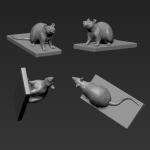
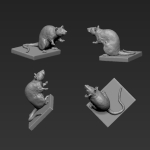
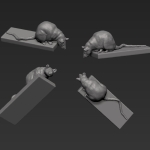
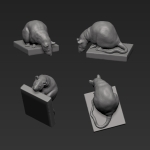
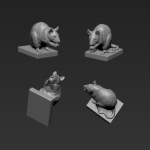
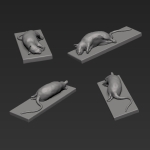
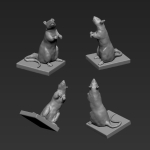
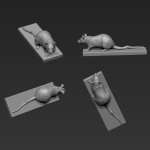
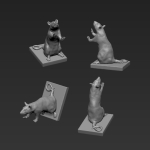
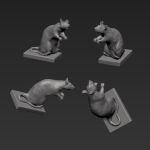
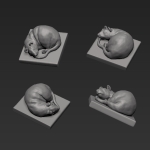
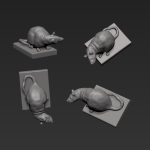
Trench Rat Set / Rattenpack Set – Rattus norvegicus
- Scale / Maßstab: 1:32 / 1:35
- Material: Resin
- Parts / Teile: 13
- Code: RAT04
Contents / Inhalt:
- Rat Pack – 13 x Rats / Rattenpack – 13 Stck. Ratten
The pictures above are the rats 1 – 13. Below is the list of each rat with title / description.
- Rat 1 – Standing – Low
- Rat 2 – Standing – Middle
- Rat 3 – Standing – High 1
- Rat 4 – Looking Down – Straight
- Rat 5 – Looking Down – Left
- Rat 7 – Sitting – Eating
- Rat 8 – Dead – Side
- Rat 9 – Standing – High 2
- Rat 10 – Standing – Low – Head Right
- Rat 12 – Standing – (with SRD)
- Rat 13 – Standing – (in German Helmet)
- Rat 14 – Sleeping – (in German Helmet)
- Rat 15 – Inside – (inside SRD)
Information about this kit:
The Common Rat: Actually, when one talks about rats, then there are two best known rat species – the brown rat (Rattus norvegicus) and the black rat (Rattus rattus- also known as the ship rat, roof rat, and house rat). I have chosen to create a set of the larger of the two groups, the brown rat, which is the dominant rat in Europe and much of North America.
These model rodents are intended to enhance any dioramas or modelling scenes, historical or otherwise, but particularly models of the Great War period, where the Norway rat was particularly dominant. They have been created in the large 1:16th scale / 120mm and the smaller 1:32nd or 1:35th scales / 54mm sizes. As these creatures varied in sizes, the differences between the smaller scales is virtually unnoticeable.
The Naming: Originally called the Hanover rat, the brown rat has had many different names throughout history, but is nowadays correctly called Norwegian rat or Norway rat (Latin: Rattus norvegicus). Why it was called this is not certain, as the brown rat did not originate from Norway, or at the time had any brown rat entered this country. Other names include common rat, street rat, sewer rat, brown Norway rat and wharf rat.
Description: These brown or grey rodents will average a body length of up to 25 cm, with a similar tail length. The male rat is larger than the female and can weigh around 300 – 350g, twice as much as the smaller black rat or Rattus rattus. Under good conditions, the brown rat can weigh up to 900 – 1000g, although this is seldom seen. The fir is coarse and usually brown or dark grey in colour, with the underside or belly area a much lighter, or light grey tone. The ears, feet, tip of nose and tail are without fir and will normally have a lighter colour. The eyes are nearly always black without any white showing.
A female rat may breed up to 6 – 7 times a year, with each litter numbering from 2 – 14. The Norway rat is fully grown in approx. 4 weeks and will live up to 3 years. The rats are found anywhere there are people, but particularly in urban areas – this is called commensalism, which means that one species helps another species, without any help in return.
The rat burrow (nest) consists of networks of tunnels and chambers, linked together with passageways. Here they will live together as a group or pack (sometimes called a colony). Rats will cache their food and store within the chambers. The burrows are found in ditches, cellars, sewers, barns, old buildings, woods and marchlands or just anywhere near a food supply (near humans). They will defend their burrow as a group against predators. The brown rat has exceptionally good hearing and is often found near water. They are good climbers, swimmers and have a strong sense of smell. They will normally hunt at night in packs.
The trench systems of the Great War on both sides offered the ideal living conditions for the Norway rat and there is much evidence from soldiers describing their co-habitants.
Predators: The natural predators of rats include the snake, fox, weasel, birds of prey, cat and dog. In the trenches during the Great War, apart from the soldiers, it was the dogs which helped to keep the rat population under control (or as best as possible under the circumstances). It seems that any of the terrier family were quite common as rat killers. There are also many photos of Jack Russells, particularly kept by German troops.
Notes from the Sculptor
The anatomy or body shape of the Norway rat is a relatively complicated object to cast in one piece. The long, solid bodies, with thin, protruding ears, legs and long tails makes this work a challenging task. An alternative would have been to choose the rat poses in the lesser complicated forms, such as rolled up, with the tail always against the body (similar to Rat No. 14 – Sleeping Rat). This would have made the casting task a lot easier, but simultaneously left out the more common and expected moving, sitting and standing rat poses. I chose the latter, with various natural poses copied from real rats and original WW1 photographs. The sizes have also been varied slightly, giving a natural mix of a group of rats, with young and old together. The fir surface and distinguished tail textures have been re-created, with a lesser or smoother underside to these small animals.
Removing rats from blocks – 1:32nd / 54mm or 1:35th scale versions: All the rats have the same poses as the larger 1:16th / 120mm versions, with the main exception of being all mounted directly onto small stands without any space in between. In most cases it would not be advisable to remove the rats from the stands as tails and legs are too small and thin in this scale. Here it would make sense to build the rats into a diorama or modelling scene, including the stand as required. Dead Rat No. 6 & Rat on SRD Jar No. 11 are the only ones not included within the smaller version set – here the poses of these rats, with extended / hanging down tails and legs pointing out of body etc., does not allow for a good casting technique or solution.
 An deutschsprachige Interessenten:
Sie können mich per eMail oder Telefon auch gerne auf deutsch kontaktieren. Ortsbesuch ist nach Absprache möglich.
An deutschsprachige Interessenten:
Sie können mich per eMail oder Telefon auch gerne auf deutsch kontaktieren. Ortsbesuch ist nach Absprache möglich.
